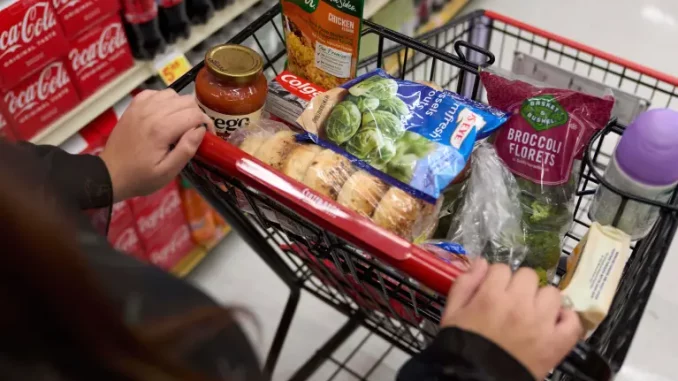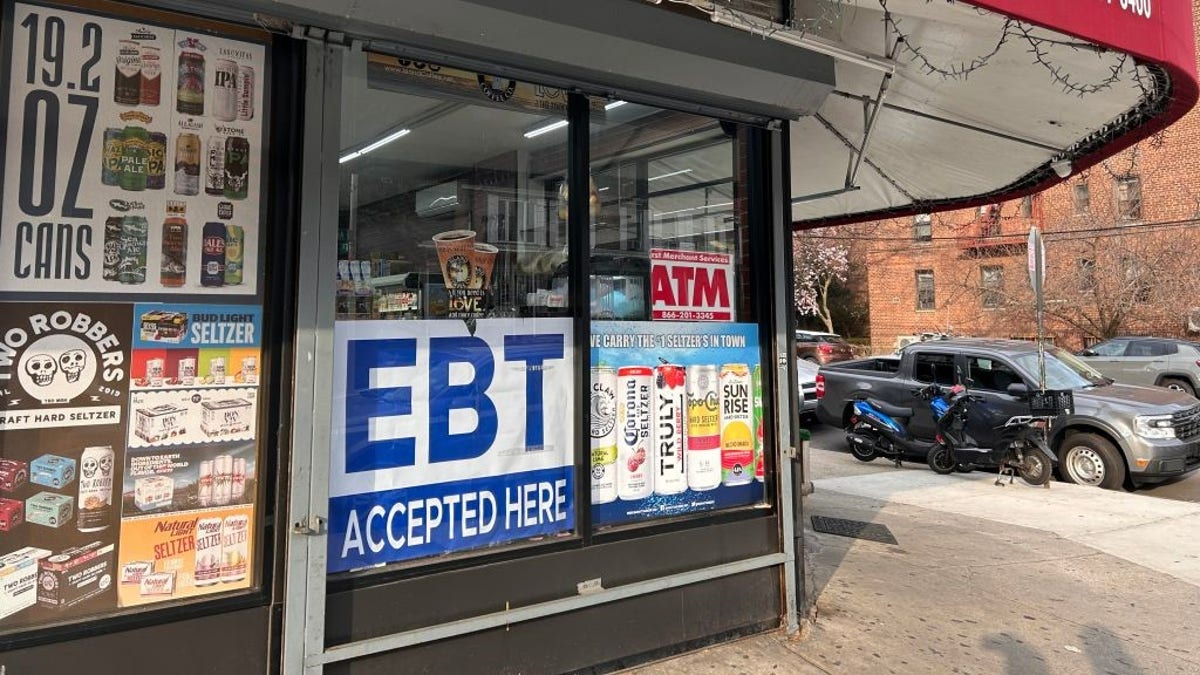
A California’s SNAP benefits shopper pushes a cart through a supermarket in Bellflower, Calif., Feb. 13, 2023. (AP Photo/Allison Dinner, File)
Published October 26, 2025
As the federal government shutdown stretches into its fourth week, a quiet but devastating consequence is looming for millions of Americans. The U.S. Department of Agriculture (USDA) has confirmed that it will not use emergency or contingency funds to continue the Supplemental Nutrition Assistance Program (SNAP) beyond October — leaving more than 42 million low-income Americans at risk of losing food benefits on November 1.
A funding standoff turns personal
The shutdown, triggered by a spending impasse in Congress, has frozen appropriations across federal agencies. Among the most critical casualties is SNAP, the nation’s largest anti-hunger program. The USDA said in an internal memo that it lacks the legal authority to “shuffle or reprogram funds” to maintain benefits during the shutdown, describing its remaining contingency reserves as off-limits for anything other than “true emergencies,” such as natural disasters.
That decision marks a stark shift from previous shutdowns, when federal officials used temporary funds or early payments to soften the blow. This time, the agency is holding the line — and leaving the fate of millions in congressional hands.
States and families brace for fallout
The effects could be immediate. Families relying on SNAP typically receive their electronic benefit transfers (EBT) at the start of each month. Without congressional action, that assistance will vanish in November. Governors and local officials are scrambling: some, like Virginia’s administration, are exploring emergency declarations, while others, such as Tennessee’s, say they lack the authority or budget to fill the gap.
Food banks nationwide are already preparing for a surge in demand. Charitable organizations in major cities warn that their supplies, already strained by inflation and rising grocery prices, will not be able to absorb the sudden loss of federal aid.
Political crossfire
The blame game in Washington has intensified. Republicans accuse the Biden administration of weaponizing the shutdown to apply pressure for a spending deal, arguing that the USDA could, if it chose, extend benefits temporarily. Democrats counter that Republican lawmakers are holding essential programs hostage by refusing to pass a clean continuing resolution to reopen the government.
Fox News reports that frustration is mounting even within some Democratic circles, with lawmakers warning that the optics of “children going hungry” could spark a national backlash. The Hill notes that several moderates have floated a standalone SNAP funding measure to avert a humanitarian crisis, though House leaders have not brought it to a vote.
A program too big to pause
SNAP costs roughly $8 billion a month — far more than the USDA’s estimated $5–6 billion contingency fund. Even if the agency reversed its decision, those reserves could not cover a full cycle of benefits for November. Axios notes that, unlike in previous shutdowns, USDA lawyers are interpreting the Antideficiency Act strictly, prohibiting the use of stopgap measures not explicitly approved by Congress.
The Pennsylvania Capital-Star reports that the agency’s decision came after internal deliberations revealed no legal route to advance funds without violating federal budget law. In short, unless lawmakers pass new funding, the USDA’s hands are tied.
The human and economic stakes
The potential halt in food aid reaches far beyond individual households. SNAP benefits sustain a significant share of grocery spending in low-income communities. Analysts warn that a cutoff could reduce consumer demand, hit small retailers, and strain local economies already battling high food inflation.
For the 42 million Americans who depend on SNAP — including working parents, seniors, veterans, and the disabled — the looming cutoff is more than a bureaucratic failure. It’s a question of survival.
As Congress debates spending priorities, time is running out. Without a breakthrough, November could begin with empty EBT cards — and a painful reminder of how political gridlock in Washington can hit hardest at America’s dinner tables.

A local bodega with “EBT accepted here” sign in window in Queens, New York. (Lindsey Nicholson/UCG/Universal Images Group via Getty Images)

Produce at a Virginia grocery store in 2011. (Photo by Lance Cheung/U.S. Department of Agriculture)
 Implications of the SNAP funding freeze and USDA’s decision not to use contingency funds — organized by social, economic, and political dimensions:
Implications of the SNAP funding freeze and USDA’s decision not to use contingency funds — organized by social, economic, and political dimensions:
1. Social Implications
-
Immediate food insecurity – Over 40 million Americans, including children, seniors, and veterans, face the possibility of missing their November food benefits. The impact will be most severe for families living paycheck-to-paycheck or already relying heavily on SNAP for basic meals.
-
Strain on community support systems – Food banks, churches, and local charities will face overwhelming demand. Many are already stretched due to inflation and higher grocery costs.
-
Psychological impact – Families living in uncertainty may experience heightened stress, anxiety, and distrust in the government’s ability to protect vulnerable citizens.
-
Potential rise in hunger-related crime – When basic needs are unmet, some localities might see increases in petty theft or other survival-driven offenses.
2. Economic Implications
-
Reduced consumer spending – SNAP injects around $8–9 billion monthly into the economy, mainly through grocery purchases. A halt could slow retail sales, especially in small towns and rural areas where SNAP usage is high.
-
Ripple effect on food retailers – Grocery stores, especially those in low-income areas, depend on SNAP spending. A lapse could lead to inventory surpluses, waste, and temporary layoffs.
-
Agricultural and supply chain impact – Less demand for food products means reduced wholesale orders, hurting farmers, food processors, and distributors.
-
Inflation pressure in reverse – Ironically, while SNAP cuts could lower demand and slightly ease prices, the social cost of increased hunger far outweighs this economic effect.
-
Local economy stress – States with high SNAP participation (Mississippi, New Mexico, Louisiana, West Virginia) could see the steepest drop in consumer activity.
3. Political Implications
-
Public backlash and blame-shifting – The USDA’s decision not to release contingency funds has ignited political blame. Democrats say Republicans are holding the program hostage; Republicans claim the administration is using the issue to push a broader spending deal.
-
Erosion of trust – Millions of citizens watching benefits dry up may lose confidence in both parties, reinforcing cynicism about Washington’s priorities.
-
Policy precedent – The USDA’s refusal sets a new boundary: agencies cannot use contingency funds during shutdowns without explicit congressional approval. Future administrations may face the same dilemma.
-
Pressure for bipartisan reform – Lawmakers may push for legislation to permanently exempt SNAP and other safety-net programs from shutdowns, treating them as “essential services.”
-
Election-year fuel – The optics of hunger during a political standoff could become a major talking point in upcoming races, shaping voter sentiment around competence, compassion, and fiscal responsibility.
4. Humanitarian and Long-Term Implications
-
Health deterioration – Interrupted food access leads to poor nutrition, higher rates of illness, and long-term effects on child development.
-
Widening inequality – Wealthier Americans are unaffected by the shutdown, while the poorest bear the brunt — deepening class divides.
-
Charitable fatigue – As private aid organizations try to fill the gap, donor fatigue could set in if the shutdown continues or repeats.
-
Moral reckoning – The situation raises ethical questions about whether food access should ever depend on political negotiations.
 Overall Takeaway:
Overall Takeaway:
The SNAP crisis unfolding during this shutdown underscores a hard truth about Washington’s spending culture: America’s safety nets have become political leverage, not instruments of stewardship. For decades, both parties have allowed entitlement programs to expand without sustainable reforms, creating a system so dependent on federal appropriations that one budget standoff can threaten the dinner tables of 40 million people.
The USDA’s refusal to stretch its contingency funds might be unpopular, but it reflects a deeper principle—laws and budgets must be honored, not bent for convenience. Fiscal discipline means recognizing limits, even when the moral impulse is to spend beyond them. Federal agencies were never meant to operate on emergency funding as a substitute for legislative responsibility.
Critics argue that Congress should have ensured continuity for vital programs like SNAP long before the shutdown began. They’re right. But the solution isn’t to keep printing money or expanding welfare dependency. It’s to build a leaner, more efficient safety net—one that rewards work, reduces bureaucracy, and empowers states, churches, and communities to play a greater role in caring for the vulnerable.
If Washington wants to prevent future crises like this, it must stop governing through brinkmanship and rediscover the balance between compassion and accountability. Helping struggling families is a moral duty—but so is protecting taxpayers from endless debt and ensuring that America’s aid systems remain temporary ladders, not permanent lifelines.
SOURCES: THE HILL – SNAP funding expiration set to hit 40 million people
FOX NEWS – Democrats under fire as food stamp funds run dry: 42 million Americans caught in shutdown fight
AXIOS – Exclusive: USDA says it can’t use emergency funds for food stamps
PENN CAPITAL STAR – USDA won’t shuffle funds to extend SNAP during shutdown, in about-face from earlier plan





Be the first to comment